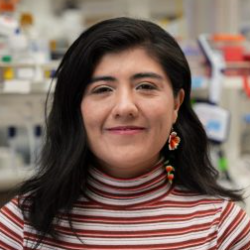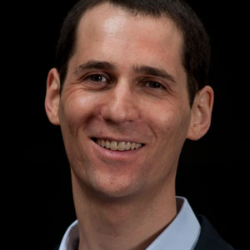Cambridge Healthtech Institute's Inaugural
Models for de novo Design
Creating Antibodies in silico
January 14 - 15, 2025 ALL TIMES PST
Tuesday, January 14
7:30 amRegistration and Morning Coffee
PLENARY KEYNOTE SESSION
The State of the Art for Antibody Structure Prediction
 Victor Greiff, PhD, Associate Professor, University of Oslo and Director of Computational Immunology, IMPRINT
Victor Greiff, PhD, Associate Professor, University of Oslo and Director of Computational Immunology, IMPRINT
Antibody structure prediction is pivotal for understanding antibody function and for enabling in silico antibody design. This lecture will outline current key advances as well as unresolved challenges in antibody structure prediction.
Design of New Protein Functions Using Deep Learning
 David A. Baker, PhD, Henrietta & Aubrey David Endowed Professor, Biochemistry, University of Washington
David A. Baker, PhD, Henrietta & Aubrey David Endowed Professor, Biochemistry, University of Washington
Proteins are biology's workhorses. Our goal is to create new proteins that address current-day problems not faced during evolution. Rather than modify naturally occurring proteins, we design new ones from scratch to optimally solve the problem at hand. Increasingly, we develop and use deep learning methods to generate protein sequence, structure, and function. We then characterize these designed molecules experimentally. In this talk, I will describe several recent projects.
LATEST TOOLS AND APPROACHES FOR DESIGNING PROTEINS USING MODELS
Accelerating Biologic Drug Discovery with AI: Advancements and Challenges in de novo Antibody Design
 Per Greisen, PhD, President, BioMap
Per Greisen, PhD, President, BioMap
The urgent need for novel biologics demands accelerated drug discovery. We leverage AI to expedite therapeutic antibody development, showcasing our progress in de novo design of VHH and mAbs targeting specific epitopes. We'll discuss the strengths and limitations of current AI algorithms, challenges in translating designs into functional molecules, and strategies to refine these algorithms for improved de novo biologic design success.
Developing and Implementing an Effective IP Strategy for an AI/ML-Driven Biologics Therapeutic Program
 Matt Wheeler, PhD, JD, Senior Associate, Patents and Innovations Group, Wilson Sonsini Goodrich & Rosati
Matt Wheeler, PhD, JD, Senior Associate, Patents and Innovations Group, Wilson Sonsini Goodrich & Rosati
This talk will focus on understanding IP rights, inventorship, and ownership of AI/ML-based inventions including platform aspects and therapeutic modalities. Deciding between patenting and maintaining trade secret aspects of the platform and modalities will be discussed. It will review life cycle management strategy for a biologics therapeutic program and Freedom to Operate.
11:05 amGrand Opening Coffee Break in the Exhibit Hall with Poster Viewing
Steering Protein Language Models for Functional Protein Design
 Jeffrey Ruffolo, PhD, Head of Protein Design, Profluent Bio
Jeffrey Ruffolo, PhD, Head of Protein Design, Profluent Bio
Protein language models trained on evolutionarily diverse sequences implicitly model the sequence-function landscape of proteins. These models learn to generate diverse sequences, but must be steered for protein design tasks. We first discuss the generation of diverse CRISPR-Cas effectors for genome editing applications through fine-tuning on curated natural sequences. Next, we present a strategy for steering protein language models through conditioning on structural and functional context.
De novo Designed Proteins Neutralize Lethal Snake Venom Toxins
 Susana Vazquez Torres, PhD Student, Protein Design, University of Washington
Susana Vazquez Torres, PhD Student, Protein Design, University of Washington
Snakebite envenoming remains a devastating and neglected tropical disease, claiming over 100,000 lives annually and causing severe complications and long-lasting disabilities for many more. Three-finger toxins (3FTx) are highly toxic components of elapid snake venoms that can cause diverse pathologies, including severe tissue damage and inhibition of nicotinic acetylcholine receptors (nAChRs) resulting in life-threatening neurotoxicity. Currently, the only available treatments for snakebite consist of polyclonal antibodies derived from the plasma of immunized animals, which have high cost and limited efficacy against 3FTxs. Here, we use deep learning methods to de novo design proteins to bind short- and long-chain α-neurotoxins and cytotoxins from the 3FTx family. With limited experimental screening, we obtain protein designs with remarkable thermal stability, high binding affinity, and near-atomic level agreement with the computational models. The designed proteins effectively neutralize all three 3FTx sub-families in vitro and protect mice from a lethal neurotoxin challenge. Such potent, stable, and readily manufacturable toxin-neutralizing proteins could provide the basis for safer, cost-effective, and widely accessible next-generation antivenom therapeutics.
1:30 pmRefreshment Break in the Exhibit Hall with Poster Viewing
NEXT STEPS FOR PREDICTING MOLECULAR DYNAMICS AND FUNCTIONAL EFFECTS OF MUTATIONS
Deep Learning Guided Design of Dynamic Proteins
 Tanja Kortemme, PhD, Professor, Bioengineering & Therapeutic Sciences, University of California, San Francisco
Tanja Kortemme, PhD, Professor, Bioengineering & Therapeutic Sciences, University of California, San Francisco
Methods from artificial intelligence can now “write” proteins de novo, without starting from proteins found in nature. I will discuss our recent progress with developing deep learning models for de novo protein design, demonstrating that they generalize beyond the training space, and applying them to difficult problems, including atomically accurate design of dynamic proteins. Exciting frontiers lie in constructing synthetic cellular signaling from the ground up using de novo proteins.
Machine Learning Coarse-Grained Potentials of Protein Thermodynamics
 Klara Bonneau, PhD Student, Computational Biophysics, Freie Universität Berlin
Klara Bonneau, PhD Student, Computational Biophysics, Freie Universität Berlin
Coarse-grained (CG) models are an alternative to the expensive all-atom models, but reaching high predictive power has been a longstanding challenge. By combining deep learning methods with a diverse training set of protein simulations, we have developed a CG force field which can be used for molecular dynamics on new sequences not used during model parametrization. This showcases the feasibility of a universal and efficient CG model for proteins.
Decoding Molecular Mechanisms for Loss of Function Variants
 Matteo Cagiada, PhD, Postdoctoral Fellowship Program, Novo Nordisk Foundation, University of Copenhagen
Matteo Cagiada, PhD, Postdoctoral Fellowship Program, Novo Nordisk Foundation, University of Copenhagen
Proteins are essential for cellular function, and missense variants can cause genetic disorders by destabilizing proteins or disrupting key interactions. While prediction of deleterious variants has progressed, understanding of the molecular mechanisms behind these variants remains limited. Thanks to advances in sequence- and structure-based computational predictors, we can now unravel the molecular mechanisms behind loss-of-function and quantify the role of stability in disrupting protein function.
3:35 pmRefreshment Break in the Exhibit Hall with Poster Viewing
TABLE 2: How Open Competitions Provide Valuable Benchmarking to Novel Technologies
 Matthieu Schapira, PhD, Principal Investigator, Structural Genomics Consortium, Professor, Pharmacology & Toxicology, University of Toronto
Matthieu Schapira, PhD, Principal Investigator, Structural Genomics Consortium, Professor, Pharmacology & Toxicology, University of Toronto
- Why benchmarking is needed
- Designed competitions, and accidental ones
- Lessons from CACHE
- The AIntibody competition to assess computational methods in antibody discovery
TABLE 3: Designing Functional Proteins Using Generative AI Models
 Jeffrey Ruffolo, PhD, Head of Protein Design, Profluent Bio
Jeffrey Ruffolo, PhD, Head of Protein Design, Profluent Bio
- What types of protein design problems are generative AI models useful for?
- How should we leverage biophysical principles when using generative AI?
- When should we use sequence- vs. structure-based models?
- What types of new data would be most useful for generative AI design platforms?
TABLE 4: AI-Driven Biologics: Accelerating Discovery, Overcoming Challenges
 Per Greisen, PhD, President, BioMap
Per Greisen, PhD, President, BioMap
- Motivation: The urgent need for novel biologics is driving the exploration of AI in drug discovery
- Focus: AI's potential in accelerating biologic drug discovery, particularly de novo antibody design
- Showcase: Successful AI-driven VHH and mAb designs
- Discussion: AI's strengths in predicting antibody structures, challenges in translating designs into functional molecules, achieving industrial-scale reliability, and closing the gap between computational and experimental results
Targeted de novo and in silico Design of Proteins and Peptides
 Monica L. Fernandez-Quintero, PhD, Staff Scientist, General Inorganic & Theoretical Chemistry, Scripps Research Institute
Monica L. Fernandez-Quintero, PhD, Staff Scientist, General Inorganic & Theoretical Chemistry, Scripps Research Institute
- What can be designed at this point?
- What resources need to be realistically invested to get a hit?
- What are the best tools/workflows out there? How do you decide which one to use?
 Jeffrey J. Gray, PhD, Professor & Research Mentor & Outreach Advisor, Chemical & Biomolecular Engineering, Johns Hopkins University
Jeffrey J. Gray, PhD, Professor & Research Mentor & Outreach Advisor, Chemical & Biomolecular Engineering, Johns Hopkins University
6:30 pmNetworking Reception in the Exhibit Hall with Poster Viewing
7:30 pmClose of Day
Wednesday, January 15
7:45 amRegistration and Morning Coffee
PLENARY KEYNOTE SESSION
ML-Powered "Lab-in-the-Loop" Approach for Therapeutic Antibody Discovery and Optimization
 Vladimir Gligorijević, PhD, Senior Director, AI/ML Prescient Design, Genentech
Vladimir Gligorijević, PhD, Senior Director, AI/ML Prescient Design, Genentech
In this talk, I will review our latest machine-learning approaches for antibody design and multi-property optimization that we use in our "Lab-in-the-Loop" (LitL) system. I will demonstrate how we use our LitL system to overcome some of the critical antibody design challenges and accelerate drug discovery programs.
LATEST TOOLS AND APPROACHES FOR DESIGNING PROTEINS USING MODELS
Discovering Safe, Effective Drugs via Learning and Simulation of 3D Structure
 Ron Dror, PhD, Professor, Computer Science, Artificial Intelligence Lab, Stanford University
Ron Dror, PhD, Professor, Computer Science, Artificial Intelligence Lab, Stanford University
Recent years have seen dramatic advances in both experimental determination and computational prediction of macromolecular structures. These structures hold great promise for the discovery of highly effective drugs with minimal side effects, but structure-based design of such drugs remains challenging. I will describe recent progress toward this goal, using both atomic-level molecular simulations and machine learning on three-dimensional structures.
AI Tools for Antibody Engineering
 Jeffrey J. Gray, PhD, Professor & Research Mentor & Outreach Advisor, Chemical & Biomolecular Engineering, Johns Hopkins University
Jeffrey J. Gray, PhD, Professor & Research Mentor & Outreach Advisor, Chemical & Biomolecular Engineering, Johns Hopkins University
AI has become increasingly powerful but can be overhyped. Our lab has used AI methods to develop antibody language models, antibody structure prediction models, protein-protein docking models, and antibody design models. I will share recent results, including testing language models’ comprehension of biological antibody maturation processes, benchmarking antibody developability models, and bringing physical energies back into AI predictions. Our results suggest how to use AI tools with appropriate caution.
De novo Design of Epitope-Specific Antibodies Against Soluble and Multipass Membrane Proteins with High Specificity, Developability, and Function
 Adithya Paramasivam, ML Scientist, Nabla Bio Inc
Adithya Paramasivam, ML Scientist, Nabla Bio Inc
We present JAM, a generative protein design system that enables fully computational design of antibodies with therapeutic-grade properties for the first time. JAM generates antibodies that achieve double-digit nanomolar affinities, strong early-stage developability profiles, and precise targeting of functional epitopes without experimental optimization. We demonstrate JAM's capabilities across multiple therapeutic contexts, including the first fully computationally designed antibodies to multipass membrane proteins - Claudin-4 and CXCR7.
10:50 amBagel Booth Crawl with Coffee in the Exhibit Hall with Poster Viewing (Sponsorship Opportunity Available)
PLENARY KEYNOTE SESSION
1:00 pmClose of Models for de novo Design Conference














